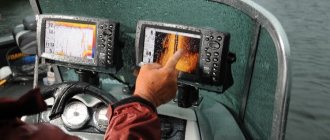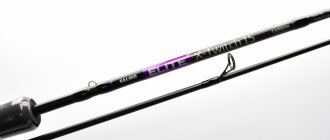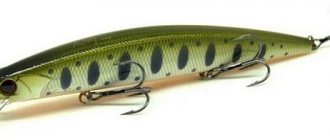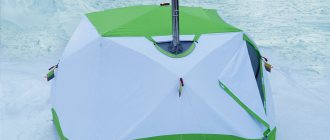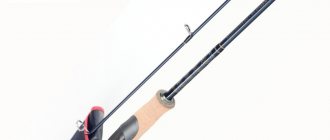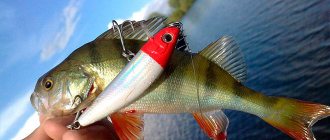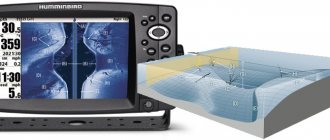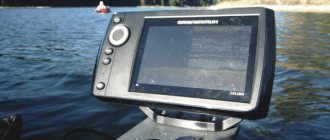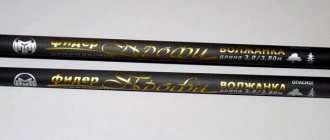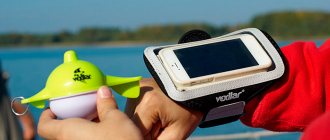An echo sounder is a device designed to determine the depth of a reservoir, study the structure and topography of the bottom, and search for fish. The very first echo sounders were developed for military use to detect enemy submarines. Later, echo sounders became widespread and began to be widely used for fishing and controlling river and sea vessels. Echo sounders can be used both for fishing in summer and winter, both when fishing from a boat and from the shore. There are a huge number of echo sounder models on the market, differing in functions, characteristics and cost.
In our publication, we will try to understand the operating principles of echo sounders, their technical characteristics and parameters, tell you about the principles for choosing a specific echo sounder model, and give a rating of the 10 best echo sounders in terms of price-quality ratio.
What is an echo sounder for?
One of the main tasks of an angler when fishing is to find fish sites. Experienced fishermen use various methods for this:
- The parking place is indicated by fish coming to the surface, accompanied by splashes.
- Flocks of seagulls circling in one place, indicating the presence in this place of large concentrations of fry, and therefore predators
- Favorite sites for predatory fish associated with the bottom topography: holes, whirlpools, coastal and channel edges, areas with reverse flows, areas with branches of trees and shrubs hanging over the water.
It can be useful for an angler to know in which depth horizon the fish is located on the day of fishing: the fish can be standing at the bottom, at half-water or at the very surface.
A modern electronic device—an echo sounder—helps answer all these questions. The use of fish finders by fishermen has changed fishing in many ways. Detailed information gives the angler using a fish finder a huge advantage.
The echo sounder allows you to:
- Determine, with high accuracy, the depth at the fishing site
- Study the general topography of the bottom, detect the presence of edges, depressions, and ridges on the bottom
- Find large concentrations of fry and small fish that serve as food for predators
- Find a large fish site
Some anglers mistakenly think that using a fish finder will make catching fish easier than ever. In fact, this is not so, an echo sounder allows you to find promising fishing spots, but in order for fishing to be effective, the angler must be able to catch it.
Operating principle of an echo sounder
All echo sounders have a similar principle of operation. The echo sounder transmitter generates an electrical pulse, which is converted into an ultrasonic signal. The ultrasonic signal beam is directed towards the bottom.
The ultrasonic signal passes freely through the water column, is reflected from the bottom and any other underwater objects, including fish, and returns back to the echo sounder, where it is picked up by the receiver.
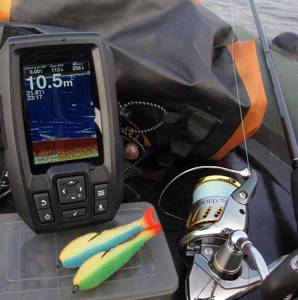
Data from the receiver enters the processor, which processes it. The echo sounder processor analyzes the time it took for the signal to reach the obstacle and return. Since the speed of sound in water is constant, the processor, based on the signal travel time in milliseconds, calculates the distance to the object.
The processor displays on the color or black-and-white screen of the echo sounder a graphic image in the form of bottom contours and symbolic images of fish that are within the coverage area of the echo sounder beam.
Fishing echo sounder LUCKY FF-918N2 two in one, with wired and wireless sensors
Characteristics of the LUCKY FF-918N2 fishing echo sounder two in one, with wired and wireless sensors:
| Manufacturer: LUCKY. | Sonar operating frequency: for wired 200 kHz, for non-wired 125 kHz. |
| Sonar beam angle: 45 degrees for wired, 90 degrees for wireless sensor. | Food: AA. |
| Menu language: English. | Model: FF-918N2. |
| Scanning depth for wireless sensor: 60 m. | Scanning depth for wired sensor: 100 m. |
| Wired sensor cable length: 8 m. | Operating range of the wireless sensor: 150 meters. |
| Modes of use: wired and wireless. | Operating temperature: -10…50 °C. |
Description of the LUCKY FF-918N2 fishing echo sounder two in one, with wired and wireless sensors:
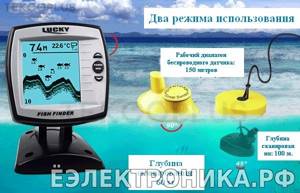
Display: 3.9-inch, high-contrast FSTN LCD, 160x132 pixels. Modes of use: wired and wireless. Backlight: on/off white LED. Built-in temperature sensor. Temperature units: Fahrenheit/Celsius. Scanning depth: for a wireless sensor 60 meters, for a wired sensor 100 meters. Sonar: Sonar beam angle: 45 degrees for wired, 90 degrees for wireless sensor. Sonar operating frequency: for wired 200 kHz, for non-wired 125 kHz. Operating temperature: -10…50 °C. Wired sensor cable length: 8 m. Wireless sensor operating range: 150 meters. Wireless sensor battery: CR-2032 (included). Power: 11-13V DC. Package size: 16x15x15 cm Package weight: 1.19 kg
The LUCKY FF-918N2 two-in-one echo sounder can work with both a wired and wireless sensor. You just need to select the sensor type in user mode.

“Wireless” mode In this mode, the LUCKY FF-918N2 two-in-one echo sounder works with a wireless sensor. When a wireless sensor is connected, the corresponding icon will appear.

“Transducer” mode: in this mode, the LUCKY FF-918N2 two-in-one echo sounder works with a wired sensor. When a wired sensor is connected, the corresponding icon will appear.

LUCKY FF-918N2 two in one is a high-tech device suitable for use in any conditions. The echo sounder automatically determines the depth, displays the structure of the bottom, and also signals the appearance of fish. For its operation, the FF-918N2 echo sounder uses sonar technology. The sensor sends sound waves that are reflected from the bottom and various objects in the water, captured by the receiver and transmitted to the head unit. The echo sounder analyzes the return time of the sound signal and calculates the depth.
The LUCKY FF-918N2 echo sounder has an intuitive interface. The upper part of the display shows the state of the water surface, depth to the bottom, water temperature, battery charge level, and sensor sensitivity. The bottom part displays the topography and structure of the bottom, as well as the lower depth value. Always monitor the condition of the echo sounder to avoid damage and extend its service life. Use a damp cloth to clean the fish finder. Do not use chemicals for cleaning. Chemicals may react and damage both the case and the display. When cleaning the FF-918N2, do not press the screen to avoid scratching it.
The delivery set of the LUCKY FF-918N2 fishing echo sounder is two in one, with wired and wireless sensors:
LUCKY FF-918N2 two in one – 1 pc. Wireless sensor (CR-2032 battery included) – 1 pc. Wired sensor – 1 pc. Suction cup mount for sensor – 1 pc. Power cable – 1 pc. Manual in English – 1 pc.
What types of echo sounders are there?
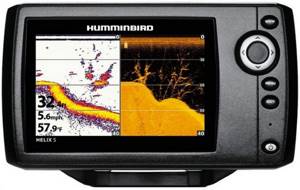
All echo sounders that are currently on the market can be divided, depending on the purpose of their use, into three groups:
- Echo sounders for winter fishing
- Echo sounders for shore fishing
- Echo sounders for fishing from a boat
Echo sounders of all three groups have a common operating principle, but each type has its own design features and differences.
Inexpensive models (up to 8,000 rubles)
LUCKY FF1108-1
pros
- price
- easy
Minuses
- no boat mount
This device is more suitable for winter due to the mounting features. Users recommend choosing a modified model with a color screen.
Practitioner 6S
pros
- universal transducer mount
- portable
Minuses
- not identified
Another budget option, included in the top of the best echo sounders for winter fishing. Quickly and accurately shows fish and where they live, as well as all floating underwater objects, down to air bubbles.
Echo sounders for winter fishing
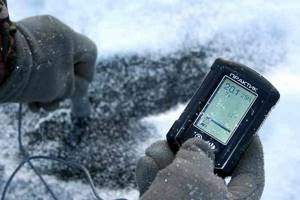
An echo sounder is needed no less for winter fishing than for summer fishing. Finding fish in winter is more difficult than in summer, and there is much less time for it.
An echo sounder allows you to find fish by making fewer holes. To use an echo sounder, you do not need to drill a full hole, just make a small hole, fill it with water, and the echo sounder sensor can work through ice.
An echo sounder for winter fishing must be: compact, reliable, in the most extreme conditions, waterproof and frost-resistant. Recently, many models have appeared that satisfy all these conditions and are sold at very reasonable prices.
Echo sounders for winter fishing are lightweight, have a compact body and easily fit into a small case. Winter echo sounders operate on batteries or a battery. Such an echo sounder can be used not only for winter fishing, but also in the summer, when fishing from a boat or from a bridge. The disadvantages of echo sounders designed for winter fishing include small screens, which are not very convenient to use.
How to choose a two-beam echo sounder for fishing?
To choose a dual-beam sonar that has optimal characteristics, you need to determine what and where it will be used, and understand the capabilities. This will save money.
The dual-beam echo sounder is universal and can be operated by a fisherman of any skill level.
This type of echo sounder uses two beams with different frequencies and coverage. A “narrow” beam is needed to study the topography and structure of the bottom; such a beam has the least degree of distortion and scattering. However, the "narrow" beam cannot detect fish. The beam radiation angle is 10-25 degrees.
The wide beam operates at a frequency of 85 Hz, has a larger beam angle and “detects” fish at any depth.
When there are sudden changes in ambient temperature, the fish stops biting normally. An important option of the echo sounder will be a temperature sensor, which records the changes that occur.
Echo sounders for shore fishing
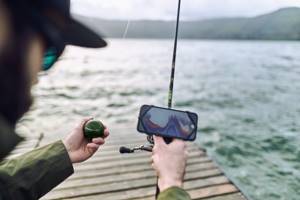
Echo sounders for fishing from the shore are a new type of devices that appeared quite recently and are gradually becoming popular among fishermen. Such echo sounders are a small-diameter ball, inside of which there is an echo sounder sensor and a wireless communication module (Bluetooth or Wi-Fi). The echo sounder is cast to a certain distance using a fishing rod and then evenly pulled towards the angler using a reel. A fisherman installs a special program on his smartphone or tablet that displays information received from the echo sounder: the depth of the reservoir, the bottom topography and the presence of fish. When choosing a wireless echo sounder, you should take into account that a fish finder with a Wi-Fi module operates at a greater distance than with a Bluetooth module. A wireless echo sounder is an excellent assistant for an angler fishing from the shore.
Wireless in the form of a float
Deeper Smart Sonar Pro
pros
- compact
- convenient case
- mobile app
- real display of the bottom and fish
- communication range
Minuses
- works in cold weather, but only up to – 20
- Doesn't always detect the device the first time
A wireless fish finder with a float-style transducer that can scan and map the bottom from shore, kayak, boat and on ice. Working with the device is made easier with the built-in GPS module.
Practitioner 7 WI-FI
pros
- easy to use
- keeps in touch well
- compact
- smartphone compatibility
- realistic bottom display
- clearly visible from a distance
Minuses
- difficulty in purchasing components
- there are failures in the “cast” mode
- not very clear instructions
This fishing device perfectly identifies fish, snags, bottom and algae. Reviews confirm that Practitioner 7 WI-FI is decent quality for a relatively low price.
Echo sounders for fishing from a boat
Boat fishing echo sounders are the largest group of echo sounders and were the first to appear on the market. A boat echo sounder consists of a sensor and a head unit, which are connected to each other by a cable.
The sensor can be mounted on the bottom of the boat or on a special bracket on the transom of the boat. The sensor can be attached to the bottom only if the boat is made of polymer materials that transmit ultrasonic waves through it. When the sensor is mounted on the bottom, errors arise in determining the depth and bottom topography due to the weakening and distortion of the signal passing through the hull of the boat, so mounting it on the transom of the boat is preferable. The external mount on the transom is more reliable; you just need to make sure that the operation of the propeller does not interfere with the operation of the sensor.
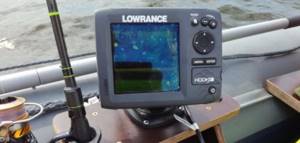
The head unit of the echo sounder is fixed in the boat in such a place that it is convenient for the fisherman to observe its screen; most often on motor boats it is placed at the stern of the boat.
As the boat moves, the fisherman sees a picture of the bottom of the reservoir on the screen and selects a promising place for fishing.
Boat fish finders are stationary devices and are not designed to be moved from one boat to another. The body of such an echo sounder is usually larger than the bodies of other echo sounders, so they often have a larger screen and more functions.
Tips for fishing with a fish finder
Before starting the device, make sure that there are no air bubbles in the water - they create serious interference. It is advisable that when measuring the depth, the boat moves slower than 10 km/h. The picture of the bottom will be good if you direct the rays into the water at different angles. If a large fish is displayed on the monitor, increase the signal sensitivity - perhaps it is a school of small fish.
Don't forget that a good echo sounder is only a tool that makes fishing from a boat easier. It cannot replace professional experience acquired over many years. Choose devices only from the ratings of trusted manufacturers. By improving your skills, you will be able to use the echo sounder correctly and please your loved ones with an excellent catch!
Technical parameters of echo sounders
Emitter frequency
Pulses sent by the echo sounder can be of different frequencies - 60 Hz, 83 Hz, 200 Hz, etc. The signal sent by the echo sounder is a cone with a certain angle.
The higher the frequency of the signal emitted by the echo sounder, the narrower the beam. A beam with a higher frequency provides a more detailed image of the bottom of the reservoir and objects in the water column, but at the same time captures a smaller area. Low-frequency beams have a wider angle, thereby capturing a larger area, but at the same time providing less detail.
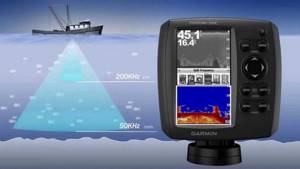
The lower the frequency of the signal, the deeper it can penetrate into the water column. The most universal would be an echo sounder with an operating frequency of 50 to 200 kHz.
An angler who plans to fish at shallow depths should choose a higher frequency sonar, while if an angler plans to fish at greater depths, he should choose a lower frequency sonar. More universal are echo sounders that have several beams, each of which operates at its own frequency.
Number of rays
An important characteristic of an echo sounder is the number of beams directed to the bottom of the reservoir. Echo sounders can have one, two or more beams. The more beams an echo sounder has, the better, but devices with more beams are more expensive.
You may be interested in: Daiwa Certate Reel
Different echo sounder beams have different frequencies and different angles; on the echo sounder screen you see the result of their combined action. The beam has a narrow angle and high frequency, well suited for close examination of the bottom structure. A beam with a wide angle and lower frequency is good for finding fish.
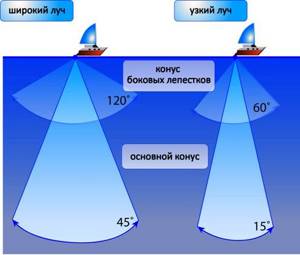
When choosing an echo sounder based on the number of beams, it is worth deciding on the goals and tasks that the device will perform.
- For winter fishing, the simplest single-beam echo sounder at 83 kHz is sufficient.
- For fishing from a boat, an echo sounder with two beams 83/200 kHz is better suited; such a device both allows you to see the overall picture of what is happening under the boat and carefully examine the structure of the bottom of the reservoir
- Tri-beam 83/200/800 kHz fish finders are suitable for fishing in large and deep rivers and lakes
- Echo sounders with 5-6 beams are used for sea fishing, to search for large schools of fish
Power
When choosing an echo sounder, you should pay attention to the power of the device. The higher the power of the echo sounder, the greater the depth it can operate.
The power of the echo sounder affects the quality of the image it displays. A low-power echo sounder can work well in shallow water areas, but when working at great depths and in holes, it will not be able to display them with sufficient clarity, much less detect whether there are fish in them.
The power of an echo sounder is directly related to its sensitivity; a powerful echo sounder with poor sensitivity will not be able to produce a high-quality picture. The power of an echo sounder is measured in watts.
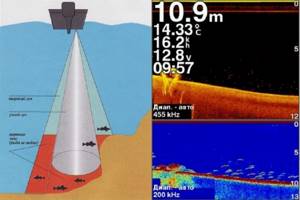
As you know, the unit of power measurement is watt, so when purchasing, pay attention to this parameter. But even if a high-power echo sounder is purchased, this is not enough for the picture on the sonar screen to be clear and understandable. Power without sensitivity means nothing and these characteristics are directly related.
- For fishing at shallow depths, an echo sounder transmitter power of 150 W is sufficient.
- For fishing at medium depths, echo sounders with a transmitter power of 200-300 W are used.
- For sea fishing at great depths, echo sounders with a transmitter power of 500 W are used, with the ability to briefly increase the transmitter power to 2400 W.
Maximum working depth
The maximum operating depth of an echo sounder is directly related to its power. The more powerful the echo sounder, the greater depths it can work with.
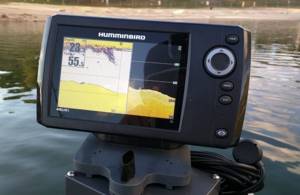
- For fishing in small bodies of water, a maximum depth of 25 meters is sufficient.
- For fishing on lakes and large rivers, you should use echo sounders with a maximum working depth of 35-80 meters.
- For sea fishing, the echo sounder must have a maximum working depth of 365 meters or more.
Viewing angle
The echo sounder beam can have a different angle, this parameter depends on the frequency of the emitter. The higher the frequency of the echo sounder emitter, the narrower the beam angle. The size of the echo sounder beam angle determines the area covered.
- 16-20 degrees - low frequency beam, allowing you to examine the bottom of the reservoir in detail
- 40-50 degrees - an echo sounder beam with this angle allows you to examine not only the bottom of the reservoir, but also a large area of the water column
- 75-90 degrees - an echo sounder beam with this angle allows you to cover a large area of the water column
Currently, many echo sounders have several beams, each of which operates at its own frequency and has its own angle.
Sensitivity
The sensitivity of the echo sounder is an important parameter that affects the clarity of the image and the amount of noise on the screen. It is best to purchase an echo sounder whose sensitivity is adjustable.
Sonar screen
The quality of the echo sounder screen has a direct impact on the information content and quality of the information display.
Echo sounders can be color or black and white. Colored echo sounder screens better display the nuances of the bottom topography, but are much more expensive.
The image quality depends on the number of colors for color echo sounders and the number of grayscale levels for black and white ones. The larger these parameters, the better.
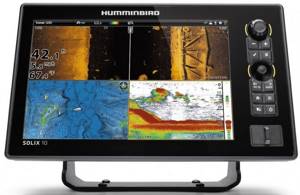
The echo sounder screen with good image brightness and contrast allows you to get a high-quality picture, even in bright sunlight. It’s good if the echo sounder screen has an anti-reflective coating.
The diagonal of the echo sounder screen can be from 2 to 10 inches. The larger the screen, the better you can see everything on it. On a fish finder with a small screen, in order to understand what is shown on it, you will often have to zoom in on the image and drag it. On the big screen everything is visible at once. The wider the echo sounder beam angle, the larger the screen needed.
Echo sounder screens differ in resolution, that is, the number of dots on the screen that determines the clarity of the picture. The more pixels the screen has, the more detailed the picture. On a low-resolution screen, a school of fish looks like a blur; on a high-resolution screen, each individual will be visible. The simplest echo sounders have a screen with a resolution of 240x240 or 240x270 pixels. Mid-level echo sounders are equipped with a screen with a resolution of 320x320 or 320x480 pixels.
Frame
The body of the echo sounder must have high-quality protection against water getting inside the device. The reliability and durability of the device directly depends on the degree of moisture protection of the echo sounder housing.

There are two most common options for housing protection:
- IP x6 - allows sea spray to reach the surface and even droplets to penetrate into the device. The echo sounder remains operational. Models with this level of protection can be mounted on the boat away from the side.
- IP x7 - the housing protection option protects the device even if it is briefly dropped into water to a depth of 1 m. This protection is especially relevant for portable echo sounders, which can accidentally fall out of your hands into the water during a rocking motion or a sharp gust of wind.
Additional features of the echo sounder
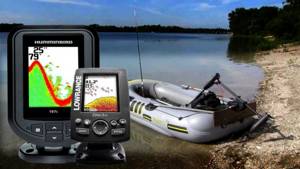
Modern echo sounders have a wide range of additional functions that can be very useful to the fisherman in certain conditions:
- GPS receiver
- can be used to mark points and record the route of the boat, having memorized the points of fish accumulation in the echo sounder’s memory, the fisherman can easily return there again, this function is especially useful for anglers who prefer to fish in large expanses of water. - Chartplotter
- an echo sounder with a chartplotter function allows you to install electronic maps with shipping data (designation of ship passages, buoys, shoals) - Temperature sensor
- shows the number of degrees at a certain depth. Knowing the water temperature at a certain depth, an angler can predict the degree of fish activity in a given area of the reservoir. - Determining the distance to the fish
- this function can be useful if you need to determine in which layer of water the fish is standing at a given time in a given body of water - Determining the size of fish
- this function is useful for anglers who catch trophy fish, so that they do not waste time catching fish that are not trophy sizes. Despite the fact that the algorithms of echo sounders are constantly being improved, you should not trust this information one hundred percent. An echo sounder may mistake snags or debris floating in the river for fish. - Flasher
is a sound notification function of an echo sounder that warns when a fish appears in the beam area.
Characteristics of echo sounders
The most important characteristics of echo sounders are:
• Sensitivity;
• Frequency;
• Number of rays.
The viewing angle of the device and the accuracy of the collected information depend on the degree of sensitivity and frequency. The number of rays affects the speed of finding fish and image quality. There are single-beam and double-beam models that notify with sound that the school is near the boat, but do not indicate its specific location. Three-beam and four-beam echo sounders give a clearer picture of underwater inhabitants, bottom structure, and are suitable for trolling. Six-ray devices that create an image in three-dimensional format most fully scan the space under the boat.
Echo sounders with bottom scanning function

The operating principle of echo sounders with a bottom scanning function differs from the operation of classic echo sounders. Echo sounders with a downscan function send out a large number of high-frequency pulses that scan the underwater space. Instead of one beam, the space is scanned by several narrower beams. The image obtained as a result of the bottom scanning function is much clearer and more detailed.
Side-scan echo sounders
Side-scan echo sounders are the next step in the development of fish finders. In such echo sounders, the beams are directed not only down under the boat, but also to the sides of it. Echo sounders with a side-scan function have the ability to scan the underwater space, to the left and right of the boat, for tens of meters. The most complete picture of the situation under water is obtained by combining information received from the side beams with information from the bottom beam.
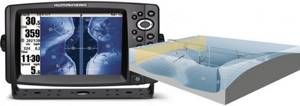
The difference in operation between classic and scanning echo sounders is that the projection of the beam of a classic echo sounder on the bottom is a circle, the diameter of which depends on the beam angle and depth, and the projection of the beams of a scanning echo sounder is a narrow strip. Therefore, in order to immediately cover the area, a boat with a scanning echo sounder needs to move.
You may be interested in: Taimen: the largest freshwater predator
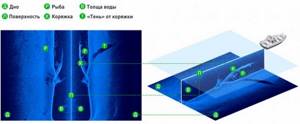
Which echo sounder to choose
An angler should choose a fish finder depending on the type of fishing he prefers.
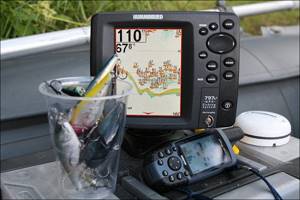
- An angler who fishes from a motor boat or boat on a large body of water, with great depths
, should choose a stationary echo sounder with a large maximum working depth, with a large screen with several beams, preferably with bottom and side scanning functions.
For example: Garmin Striker Plus 7sv, Humminbird Helix 5 Sonar G2, Lowrance Elite-7 Ti2. - For an angler fishing from a boat on a medium-sized body of water with normal depths
, a stationary echo sounder of an average price category is quite sufficient.
For example: Garmin Striker Plus 4cv, Humminbird PiranhaMAX 4, Lowrance HOOK2 4x GPS Bullet - For an angler who prefers winter fishing
, a single-beam portable echo sounder with a small black and white screen and a wide viewing angle is quite sufficient.
For example: Praktik 6M, Lucky FFW 718 - For an angler who primarily fishes from the shore
, the most preferred device would be a wireless echo sounder.
For example: Deeper Smart Sonar PRO, Deeper Smart Sonar CHIRP+
Garmin echo 151dv
Price from 13,360 to 16,190 (Average price: RUB 15,990)
Characteristics
Design
Type of echo sounder Housing location is stationary Transducer included Mounting the transducer on the transom Waterproof housing, class IPX7 Power supply 12V
Screen
Screen type black and white Number of screen colors/gradations 8 Screen diagonal 4″ Screen size 60.4×81.5 mm Screen resolution 160×256 pixels. Screen backlight available
Transducer
Number of beams 3 Output power, peak 1600 W Output power, RMS 200 W
Functions and Features
Built-in temperature sensor Sound alarm yes Detection of fish size and depth yes Display of bottom structure yes Dimensions (WxHxD) 104x147x71 mm Weight 270 g Features Garmin DownVü technology
Reviews
pros
Simplicity and reliability, build quality
Minuses
The price is a little high, it is not possible to use 2 beams or a +DV beam at once
A comment
A simple and reliable two-beam echo sounder shows everything you need and how it should (on DV it draws the bottom at 5+) compact, can be used in winter for pike perch (the trace of the spinner is visible at 200 kHz (the depth was 4 meters) 77 kHz I saw worse, but here apparently from at shallow depths. In summer, the sensor can be attached to a plastic bottle (useful on small boats) using a mount for an electric motor and dragged behind the boat (the likelihood of damaging the sensor is minimal and you don’t have to think about where to attach it to the boat)
pros
Shows average fish size and approximate depth.
Minuses
I did not expect that with the stated 488 meters in fresh water, in sea water he saw a maximum of 135 meters.
We have depths of up to 230 m. Therefore, very often it does not show pictures at all. Only when approaching the shore. 50% of the time the last measured depth flashes on the screen. It “sees” the bottom more or less stably at a depth of up to 100 m. I detected fish in the sea at an average depth of 50 meters.
At a depth of about 100 m, I came across a school about 10 m from the bottom - and the echo sounder “said” that there were no fish. When you start to lift it, it shows.
The minimum depth from the echo sounder is 1-1.2 meters. He doesn't see any less.
A comment
An ordinary normal echo sounder for fresh water bodies. Disappointed that it is not suitable for the sea.
pros
Picture quality, ease of operation, battery efficiency, fish search, sensitivity, workmanship.
Minuses
Didn't find it
A comment
I used Lawrence 4 Pro, compared to it this one is much cooler, it draws arcs perfectly, the bottom is drawn superb, the price is of course more expensive than Lorik, but it’s worth it.
I have several different ones, I have something to compare with, this one is not bad, Long View is a cool function. If the question is which one to buy between Lorik and Garmin 151 dv, then don’t think about it, take Garmin. The rating was given 4 stars only because of the price, it could have been done cheaper, although it’s a new model and all that. Garmins know their stuff. 2nd place
